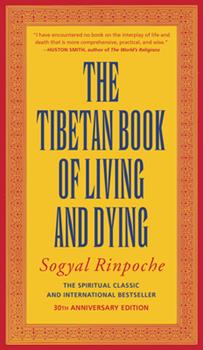Sogyal Rinpoche was born in 1947 in Kham in Eastern Tibet and is a world-renowned Buddhist teacher. He received the traditional training of a Tibetan lama under the close supervision of Jamyang Khyentse Chökyi Lodrö, one of the most outstanding spiritual masters of the twentieth century, who raised Rinpoche like his own son.
He has been teaching for over 30 years and continues to travel widely in Europe, America, Australia and Asia. He is also the founder and spiritual director of Rigpa, an international network of over 130 Buddhist centers and groups in 40 countries around the world. He is known for his ability to present his understanding of Tibetan Buddhism using the language of contemporary Western thought.
In his book The Tibetan Book of Living and Dying, which has been printed in 30 languages and 56 countries, Sogyal Rinpoche provides a manual for life and death. The book is a source of inspiration from the heart of the Tibetan tradition and provides an inspiring introduction to the practice of meditation, to the nature of mind, to karma and rebirth, to compassionate love and care for the dying, and to the trials and rewards of the spiritual path.
Despite the fact that I have heard about allegations of misconduct about Sogyal Rinpoche I decided to read the book. Besides, there are many different translations of this same book one can choose. I wanted to focus on the message and not the messenger. And if you find The Tibetan Book of the Dead extremely challenging and complicated but are interested in the topic you might like this version. It is clear, informative and insightful and very accessible because Ringpoche makes complex concepts understandable and useable.
Compassion and mindfulness are emphasized numerous times. Readers can find tools that will help them face the inevitable truth that we are all going to die, at some point. The author skillfully shares his own wisdom, that of other masters, and anecdotal evidence of what may happen when we physically die, and the stages we may go through during the process.
Topics discussed include the Bardo states, reincarnation, the concept of karma, and fear of the Unknown. The Eastern way of looking at death as only a ‘transition’ is explained in a simple manner. The book helps one to understand the true meaning of the phenomena called death and this understanding could help one to reduce the irrational fear of death.
There is quite a substantial amount of Tibetan ritual encased in this book though. Not everything might be useful for those who are not interested to delve too deeply into Tibetan Buddhism or trying to find a Guru. The Dalai Lama cautioned against rushing into commitment to a lama. “In Tibet”, he says, “it could take 12 years before a lama-disciple relationship was established.”
But what the readers learn in the book may be deeply meaningful. I personally liked that he reminded us to be loving an compassionate, no matter what others do to us; that we are responsible for everything we do, say or think; that true spirituality is to be aware that if we are interdependent with everything and everyone else, even our smallest, least significant thoughts, words, and actions have real consequences throughout the universe.
He further points out that it is extremely important to realize the nature of our mind because that way we realize the nature of all things. He points out that we in the West are terrified to look inward, because our culture has given us no idea of what we will find. In his opinion spiritual truth is not something elaborate and esoteric but common sense.
As in so many other spiritual books we read of the importance of meditation and that the gift of learning to meditate is the greatest gift we can give ourselves. But we need to create the right inner environment of the mind for our meditation. We should sit quietly, the body still, the spine straight and allow thoughts and emotions to rise, to come and to go, without clinging to anything or making any judgments. The point is not how long we meditate; the point is whether the practice actually brings us to a state of mindfulness and presence; but we do need to practice regularly.
In the chapter about Karma and Rebirth – concepts that are also addressed by Edgar Cayce in “Reincarnation and Karma“, in Theosophy, by Elizabeth Clare Prophet in “Reincarnation: The Missing Link in Christianity” – the author reminds us that the effect of our actions depends entirely upon the intention or motivation behind them, and not upon their scale. In addition, he explains that we can use every situation, however seemingly hopeless and terrible, to evolve. He recommends that we examine our actions, and become really mindful of them, so we can detect that there is a pattern that repeats itself in our actions.
In the edition from 1993, which I have read, we can read anecdotal evidence from people with near-death experiences and the author answers a few questions about death in Appendix Two, which I personally found very useful. The readers can also find different mantras and practices to prepare for death.
- What is born will die,
What has been gathered will be dispersed,
What has been accumulated will be exhausted,
What has been built up will collapse,
And what has been high will be brought low.
“The Buddha”
